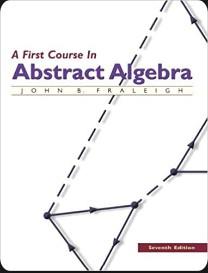Let S = {a i b j |0 i < m, 0 j < n},
Question:
Let S = {aibj|0 ≤ i < m, 0 ≤ j < n}, that is, S consists of all formal products aibj starting with a0b0 and ending with am-1bn-1. Let r be a positive integer, and define multiplication on S by (asbt)(aubv) = axby, where x is the remainder of s + u(rt) when divided by m, and y is the remainder of t + v when divided by n, in the sense of the division algorithm (Theorem 6.3).
a. Show that a necessary and sufficient condition for the associative law to hold and for S to be a group under this multiplication is that rn ≡ 1 (mod m).
b. Deduce from part (a) that the group presentation (a, b: am = 1, bn = 1, ba = arb) gives a group of order mn if and only if rn = 1
Data from Theorem 6.3
If m is a positive integer and n is any integer, then there exist unique integers q and r such that n = mq + r and 0 ≤ r < m.
Proof: We give an intuitive diagrammatic explanation, using Fig. 6.2. On the real x-axis of analytic geometry, mark off the multiples of m and the position of n. Now n falls either on a multiple qm of m and r can be taken as 0, or n falls between two multiples of m. If the latter is the case, let qm be the first multiple of m to the left of n. Then r is as shown in Fig. 6.2. Note that 0 ≤ r < m. Uniqueness of q and r follows since if n is not a multiple of m so that we can take r = 0, then there is a unique multiple qm of m to the left of n and at distance less than m from n.
Step by Step Answer:






